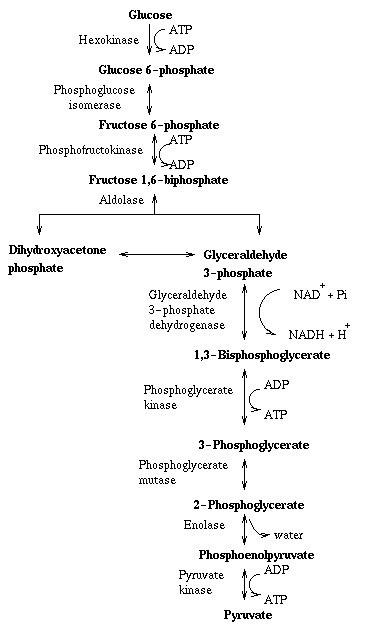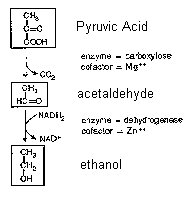
The
Chemistry of Brewing
The life
cycle of yeast in beer brewing has 3 distinct stages:
1. Initial
Period
cell wall preparation
nitrogen uptake
sugar uptake
oxygen uptake
2. Respiration
phosphorylization
carbon splitting
redox reactions
formation of pyruvic acid
formation of Acetyl CoA
Krebs Cycle
3. Fermentation
Pyruvic acid --> ethanol
In order for the yeast to make use of the abundance of 'food' in the wort, it
must first make it's cell wall permiable to the nutrients. The use of reserve
nutrition is used in this process, most notably glycogen (a healthy yeast cell
will be 40% [dry mass] glycogen). Oxygen is absorbed very rapidly into the cell.
The yeast then starts to take in amino acids, elementary peptides and sugars.
The sugars first brought through the celll wall are the simple sugars; glucose
and fructose. Sucrose is acted on by the enzyme invertase, the products; glucose
and fructose are then ingested. Maltose and Maltriose are the last sugars to
be used, they are transported across the cell wall intact and are metabolized
into glucose by a-glucosidase.
The yeast, after ingesting these nutrients, starts to respire, evolving CO2. This stage is aerobic and involves the redox reaction NAD+ --> NADH2 This phase includes vast reproduction for the cells, by means of budding. see illustration below. The last two steps, the formation of Acetyl CoA and the Krebs cycle are alternative pathways in the process and do not directly lead to the formation of ethanol. (Note that theoretically one glucose molecule will yield two ethanol molecules, this yield is significantly less due to side reactions at various intermediate points)

Ultimately the pyruvic acid created during respiration is metabolized into acetaldehyde and then to ethanol. This process is anaerobic and begins when the dissolved oxygen in solution is exhausted.
